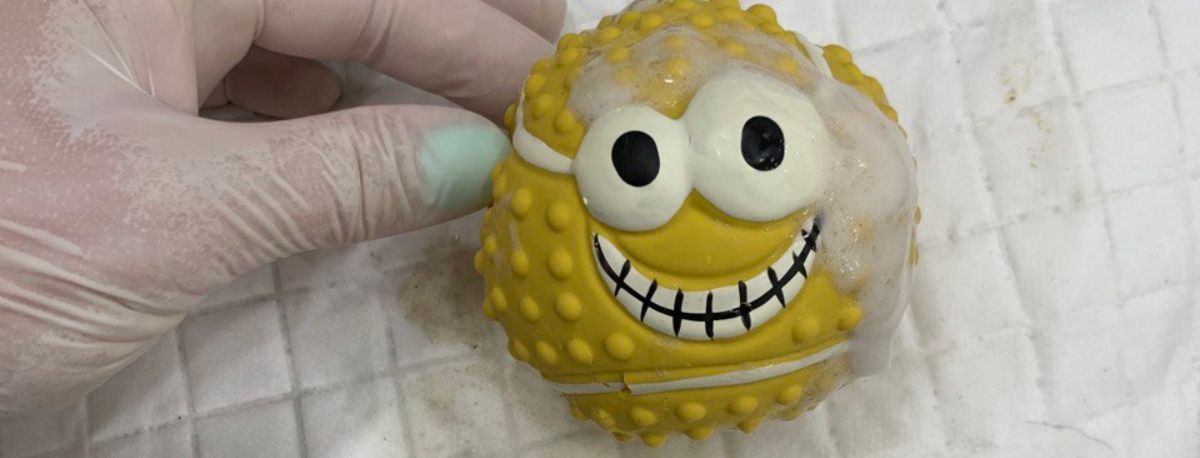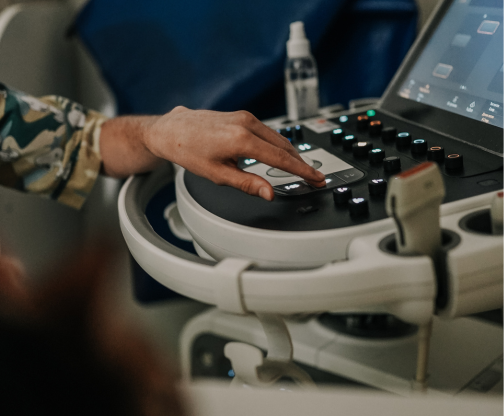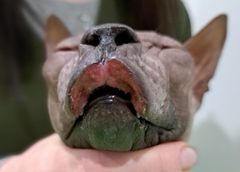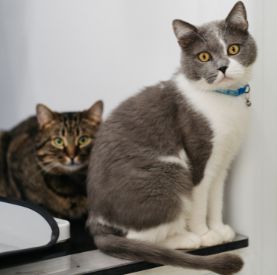Foreign objects in the gastrointestinal tract
Опубліковано
11.06.2024
Foreign objects in the gastrointestinal tract
Sooner or later, everyone who has a four-legged pet has to deal with its antics. And everyone probably has a list of chewed and missing items. Usually, very young animals tend to chew and eat anything that seems edible and attractive enough. With age, most become more prudent, but, as practice shows, not all.
The list of things to eat is actually endless, these things are not always safe and not every animal will find this experience pleasant.
So, what interesting things can your pet swallow and how will it affect their health?
In fairness, it should be noted that most of what a dog or cat eats can be successfully digested or transited and excreted in physiological feces. However, not all animals share the same ideas about the nutritional value of certain items, and it happens that peculiar culinary preferences can lead to serious health risks, and sometimes even life-threatening ones.
Let's talk about the problems that arise when eating inedible, edible, and conditionally edible items. What can go wrong and require the intervention of a veterinarian?
Eaten too much at once.
It is common to eat too much tasty but unhealthy food stolen from the table or trash can. This can lead to stomach distension, excessive stress on the gastrointestinal tract and digestive glands (liver and pancreas). Young and healthy animals tolerate such adventures relatively easily. And even when such food accidents result in malaise, gastric lavage and/or symptomatic treatment is usually sufficient.
A piece was eaten that was too big.
Sometimes it happens during the game. But more often it happens because of greed! When our future patient sees a potential competitor or is afraid of the owner, who is in a hurry to take away the "forbidden fruit", he suddenly swallows a piece that should have been chewed. In the case of a particularly unfortunate set of circumstances, the swallowed object gets stuck in the esophagus. Bones are at the top of my own hit list of foreign objects in the esophagus, but I've also seen more exotic options, such as a lump of foil that used to be wrapped in something tasty or a Christmas confetti star. A foreign object stuck in the esophagus, and most often they stop in the thoracic part of the esophagus in front of the base of the heart, causes very severe discomfort. There are difficulties with swallowing and breathing, excessive salivation, and frequent regurgitation. An X-ray examination is often sufficient to confirm the presence of a foreign body in the esophagus. X-ray is convenient because of its speed and the absence of the need for anesthesia, but the image can only confirm the diagnosis. Whereas endoscopic examination of the esophagus allows for the removal of a foreign body at the same time. If the object is edible and potentially digestible, it is usually easier to move it into the stomach than to remove it. This solution reduces the patient's time under anesthesia and reduces risks. If the object is not edible, it can be detected and removed with the help of an endoscope and special instruments. The foreign body should be removed from the esophagus as soon as possible, firstly, in most cases, the patient's condition does not allow postponing the intervention, and secondly, the longer the foreign body presses on the esophageal wall, the higher the likelihood of necrosis, which significantly worsens the patient's prognosis.
Eaten something inedible and/or obviously dangerous.
Often these are toys in whole or in fragments, textiles (rags, clothes, socks are especially attractive for some reason), packaging materials, fruit pits; threads with and without needles are especially popular with cats, hair bands, and small toys. Obviously dangerous items include blades, magnets, batteries, linear structures (threads, ribbons, ropes, garlands). Naturally, they need to be removed as soon as possible, but endoscopy is not always the best option, because on their way back from the stomach, dangerous objects damage the esophagus and pharynx again. The decision on the method of removing dangerous foreign objects is made by the doctor, taking into account the risks.
Other inedible foreign bodies that have successfully passed through the esophagus and entered the stomach have several more or less favorable exit routes for the patient.
- Variant one, favorable: The object was carefully chewed into a relatively homogeneous mass of sufficiently small fragments - most likely, it has every chance of transiting the intestines and leaving the body naturally. There is also a chance to get it back by inducing vomiting. However, it is more difficult to induce vomiting in dogs and cats than in humans. Such well-known "home" methods as pouring salt on the root of the tongue or giving hydrogen peroxide, firstly, do not always lead to the proper effect, and secondly, are not very safe. Using salt can increase dehydration and intoxication, and the peroxide solution can cause local irritation and provoke severe stomach inflammation, and this method is generally contraindicated in cats. So, if you are not hundreds of kilometers away from the nearest veterinary clinic, you should avoid such risks. If you need to induce vomiting in your dog or cat, contact your veterinarian. There are much more effective and safer medications available.
- Variant two, less favorable: the inedible substance was badly chewed and swallowed in a large piece, but successfully passed the esophagus. In this case, the size of the piece plays a very important role. If it is large enough, it is likely to remain in the stomach, as it simply will not pass through the pyloric sphincter to move to the intestines. The symptoms that will be observed depend on the placement of the object: from vomiting "fountain" in case of blockage of the pylorus to signs of chronic gastritis (decreased appetite, periodic vomiting of foam, mucus, undigested food). Foreign objects can stay in the stomach for months, which naturally does not contribute to healthy digestion. Fortunately, while a foreign body is in the stomach, there is a chance to remove it with an endoscope and avoid surgery.
The third option, the least favorable for the patient: the object was chewed into pieces of a specific size that is small enough to pass through the pyloric sphincter into the intestine and large enough to get stuck in the intestine, causing intestinal obstruction, which is a severe and life-threatening condition.
Since neither dogs nor cats bother to chew on inedible objects when swallowing them, any noticeable fact of eating something foreign should be a reason to visit a veterinarian. Remember that the evacuation of stomach contents to the intestines is quite fast. The time it takes for food to move from the stomach depends on the type of food, but it almost never takes longer than 10-12 hours and averages from 30-40 minutes to 3-4 hours. It is impossible to predict how quickly a foreign body will enter the intestines. Therefore, it should be removed from the stomach as soon as possible. Do not delay a visit to the veterinarian, do not guess whether the piece is the right size to pass through the gastrointestinal tract on its own. If a foreign object gets stuck in the intestines, it can only be removed surgically. Therefore, do not hesitate and consult a doctor at any time. The Zoolux veterinary clinic has a round-the-clock opportunity to perform endoscopic removal of foreign bodies from the stomach and esophagus.
Author of the article: endoscopic surgeon, Mikhailovskaya Evgenia
Схожі статті

Preparation for ultrasound examination (ultrasound)
It is important to remember that proper preparation of the animal can significantly facilitate the abdominal ultrasound process. By performing this procedure, the doctor can detect possible problems in time and provide proper treatment. High-tech ultrasound is one of the ways to quickly and informatively diagnose and ensure a long and healthy life for our pets.

Brachycephalic syndrome in dogs and cats.
What exactly is brachycephalic syndrome and how to live with it, how to prevent complications for the body that this syndrome can lead to?

WHY ARE DOCTORS NOT ALL-POWERFUL?
A good doctor is worth its weight in gold. Everyone understands this and can spend years looking for the best one, and when they find one, they will expect miracles.

Allergy
Allergy

SYNDROME OF TIRED TANKLES IN CATS
Tired antennae of a cat or What do you know about fatigue?

Bacterial myocarditis
This disease is extremely rare in dogs. In cats, it is even less common - 0.006-0.018% of cases.

How to protect home lovers from radiation damage.
In recent days, we have received many calls asking for advice on the need to protect animals during a possible radiation exposure.

STERILIZATION AND CASTRATION OF CATS AND DOGS
Such operations do not affect the change of the animal's character. They can be done from an early age, in particular from 8 weeks. Convenience, first of all for the animal, is that the young organism has the ability

Side effects of antiparasitic drugs
The need for tick and flea treatments for pets is a well-known fact.

How you can help calm cats and reduce stress today
the head of the felinology department, tells us.

